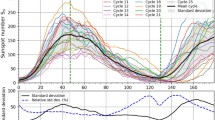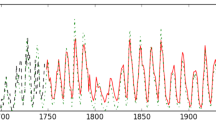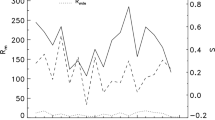Abstract
Precursor prediction techniques have generally performed well in predicting the maximum amplitude of sunspot cycles, based on cycles 10–21. Single variate methods based on minimum sunspot amplitude have reliably predicted the size of the sunspot cycle 9 out of 12 times, where a reliable prediction is defined as one having an observed maximum amplitude within the prediction interval (determined from the average error). On the other hand, single variate methods based on the size of the geomagnetic minimum have reliably predicted the size of the sunspot cycle 8 of 10 times (geomagnetic data are only available since about cycle 12). Bivariate prediction methods have, thus far, performed flawlessly, giving reliable predictions 10 out of 10 times (bivariate methods are based on sunspot and geomagnetic data). For cycle 22, single variate methods (based on geomagnetic data) suggest a maximum amplitude of about 170 ± 25, while bivariate methods suggest a maximum amplitude of about 140 ± 15; thus, both techniques suggest that cycle 22 will be of smaller maximum amplitude than that observed during cycle 19, and possibly even smaller than that observed for cycle 21. Compared to the mean cycle, cycle 22 is presently behaving as if it is a + 2.6σ cycle (maximum amplitude about 225). It appears then that either cycle 22 will be the first cycle not to be reliably predicted by the combined precursor techniques (i.e., cycle 22 is an anomaly, a statistical outlier) or the deviation of cycle 22 relative to the mean cycle will substantially decrease over the next 18 months. Because cycle 22 is a large amplitude cycle, maximum smoothed sunspot number is expected to occur early in 1990 (between December 1989 and May 1990).
Similar content being viewed by others
References
Bray, R. J. and Loughhead, R. E.: 1964, Sunspots, Chapman & Hall, London.
Brown, G. M.: 1988, Nature 333, 121.
Brown, G. M. and Simon, P. A.: 1986, in P. A. Simon, G. Heckman, and M. A. Shea (eds.), Solar-Terrestrial Predictions: Proceedings of a Workshop at Meudon, France, June 18–22, 1984, NOAA Space Environment Laboratory, Boulder, Colorado, p. 1.
Eddy, J. A.: 1977, in O. R. White (ed.), The Solar Output and Its Variation, Colorado Associated University Press, Boulder, Colorado, p. 51.
Gonzalez, G. and Schatten, K. H.: 1987, Solar Phys. 114, 189.
Greer, M. S. and Hirman, J. W.: 1989, Eos, Trans. AGU 70, 186.
Hirman, J. W., Heckman, G. R., Greer, M. S., and Smith, J. B.: 1988, Eos, Trans. AGU 69, 962.
Howard, R.: 1977, in A. Bruzek and C. J. Durrant (eds.), Illustrated Glossary for Solar and Solar-Terrestrial Physics, D. Reidel Publ. Co., Dordrecht, Holland, p. 7.
Kane, R. P.: 1978, Nature 274, 139.
Kane, R. P.: 1987, Solar Phys. 108, 415.
Langley, R.: 1971, Practical Statistics Simply Explained, revised ed., Dover Publ., Inc., New York.
Lapin, L. L.: 1978, Statistics for Modern Business Decisions, second ed., Harcourt Brace Jovanovich, Inc., New York.
Meadows, A. J.: 1970, Early Solar Physics, Pergamon Press, London.
McKinnon, J. A.: 1987, Report UAG-95, World Data Center A, Boulder, Colorado.
Ohl, A. I.: 1976, Soln. Dannye No. 9, 73.
Ohl, A. I. and Ohl, G. I.: 1979, in R. F. Donnelly (ed.), Solar-Terrestrial Predictions Proceedings, NOAA Space Environment Laboratory, Boulder, Colorado, p. 258.
Sargent, H. H., III: 1978, in Twenty-Eighth IEEE Vehicular Technology Conference, IEEE, Inc., New York, p. 490.
Schove, D. J.: 1983, Sunspot Cycles, Hutchinson Ross Publ. Co., Stroudsburg, Pennsylvania.
Schatten, K. H. and Sofia, S.: 1987, Geophys. Res. Letters 14, 632.
Thompson, R.: 1988, J. Australian Phys. 25, 17.
Waldmeier, M.: 1961, The Sunspot-Activity in the Years 1610–1960, Schulthess & Co., Zürich.
Wilson, R. M.: 1984, NASA TP-2325, NASA Marshall Space Flight Center, Huntsville, Alabama.
Wilson, R. M.: 1987, Solar Phys. 112, 1.
Wilson, R. M.: 1988a, Solar Phys. 115, 397.
Wilson, R. M.: 1988b, Geophys. Res. Letters 15, 125.
Wilson, R. M.: 1988c, J. Geophys. Res. 93, 10011.
Wilson, R. M.: 1988d, Solar Phys. 117, 179.
Wilson, R. M.: 1988e, Nature 335, 773.
Author information
Authors and Affiliations
Rights and permissions
About this article
Cite this article
Wilson, R.M. On the level of skill in predicting maximum sunspot number: A comparative study of single variate and bivariate precursor techniques. Sol Phys 125, 143–155 (1990). https://doi.org/10.1007/BF00154784
Received:
Revised:
Issue Date:
DOI: https://doi.org/10.1007/BF00154784




